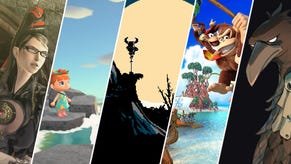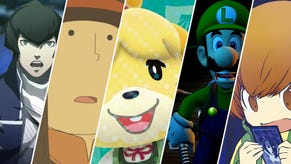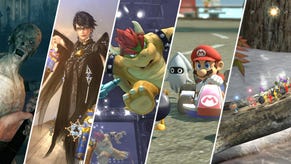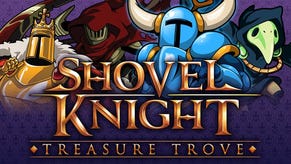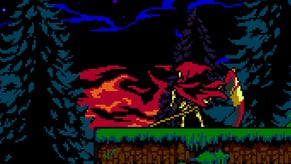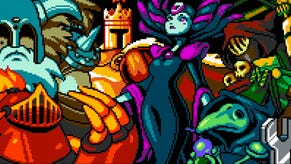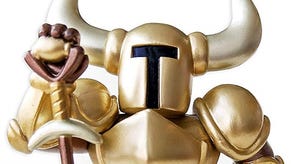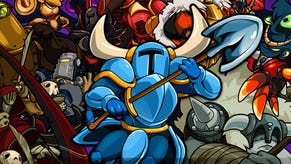2014 Recap: Shovel Knight's Surprisingly Affecting Storytelling
How Yacht Club Games turned a retro tribute something more with their own brand of visual storytelling.
This article first appeared on USgamer, a partner publication of VG247. Some content, such as this article, has been migrated to VG247 for posterity after USgamer's closure - but it has not been edited or further vetted by the VG247 team.
Take note: This recap contains major story spoilers for Shovel Knight.
In the final moments of Shovel Knight, the recently rescued heroine Shield Knight valiantly blocks the powerful magic of the Enchantress and begs Black Knight to take the wounded Shovel Knight and flee.
The moment is the culmination of a striking boss battle in which Shovel Knight and Shield Knight battle together to defeat the Enchantress, with Shield Knight blocking attacks and providing a platform to reach the Enchantress while Shovel Knight does the actual damage. It's a battle reminiscent of some of the Zelda and Link partnerships from over the years, in which Zelda is tasked with damaging Ganon using her Light Arrows, but the Shovel Knight version is more effective because Shield Knight feels like an equal partner. This isn't just a one-time thing: Shovel Knight and Shield Knight have obviously fought together many times before, and they work together better than apart.
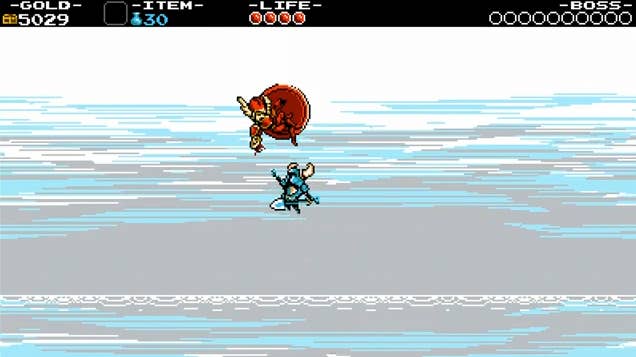
When I mentioned that special relationship to Yacht Club's David D'Angelo, who helped program Shovel Knight among numerous other responsibilities, his response was, "When we were creating Shield Knight, she started as a princess because we were looking at Roll, Peach, Zelda, and other Damsel in Distress models from the NES era. But once we gave it more careful thought, we started discussing how we could modernize and improve the model for today. We saw the idea of seeking out a loved one a worthwhile theme, but we felt in doing so, we needed to make Shield Knight just as strong a hero as Shovel Knight. In that way, we felt the connection between the player and Shield Knight would be even more powerful, as Shield Knight wouldn't be just an object—Shield Knight would be as meaningful as a loved one."
Shield Knight, of course, is absent for most of the game, but she's never far from Shovel Knight's mind. In our review back in June, I wrote: "What really surprised me though was how emotional Shovel Knight could be, which was definitely not something I was expecting from an 8-bit platformer. In one of its best sequences, Shovel Knight finds himself dreaming of his lost love—the Proto Man-like Shield Knight—by the campfire; and in his dream, you are implored to "Catch Shield Knight!" as you hack away at a host of enemies. Inevitably, there is a flash of light just as you're about to catch her and it's morning again, at which point Shovel Knight wordlessly trudges off to take on another member of the Order of No Quarter. It's a moment that reflects the medium's continued trend toward expressing emotion through gameplay, and its one that I have to say that I really like. I just wasn't expecting to find it in a retro platformer like Shovel Knight."
Reader sean697 chimed in, "What gets me is how when you are approaching her, time slows down and it's as if you are in a dream running but not going anywhere, like she is just out of reach. Touches like this really make the story in the game for me."
In the game's final scene, Shovel Knight is deposited by Black Knight next to a campfire, seemingly alone again. It's a heartbreaking image, and for a moment, it seems as if Shovel Knight is in fact a tragedy. As it turns out, that was the original plan.

We actually designed the entire story around Shield Knight dying in the end! We were shooting for the charming, goofy, but slightly sad and contemplative mood that Mother 3 so brilliantly struck," D'Angelo says. "We thought Shield Knight dying would capture this perfectly—how sad would it be to learn Shovel Knight carried a shovel because he knew his quest ended burying his loved one! Once we were implementing the story, we found that we didn't develop the characters enough for the ending to be effective—it was hard to feel anything other than cheated by the death of Shield Knight. In addition, the levity and goofiness felt squashed. So like many things in Shovel Knight, we reworked the story to its current state and landed in a much better spot: the story still evokes the Mother 3 feel we wanted, while leaving players with a much stronger connection to Shield Knight. And let's be honest, we wanted to play a co-op sequel after the final battle.
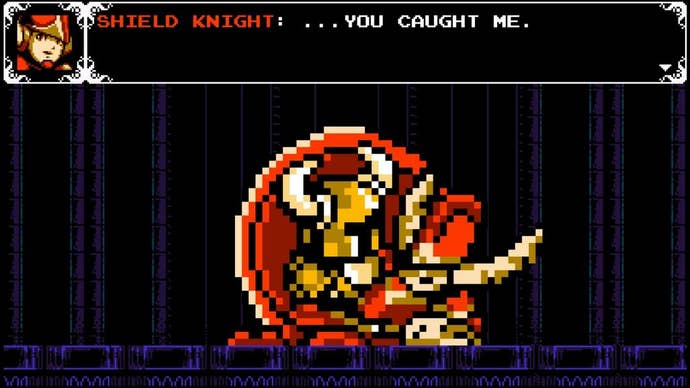
So say we all, David.
In a way, the change to Shovel Knight reminds me a little bit of Star Trek II: The Wrath of Khan, where Spock was similarly supposed to die and stay dead following a heroic sacrifice. The ending remained in place up until the last minute, but Harve Bennett was disturbed by the pall the ending cast on test audiences, concluding with a final quote from A Tale of Two Cities and fading to black. The final moments were revised to include a shot of Spock's casket intact on the Genesis planet's surface and Leonard Nimoy narrating the "Space.. the final frontier..." monologue over the strenuous objections of director Nicholas Meyer. With the changes, the somber atmosphere gave way to wild cheering, applause, and a palpable wave of relief among audiences around the country. Spock wasn't gone after all.
You can debate whether that was the right choice for Star Trek II, but I happen to like it when a story strikes a more optimistic tone, and I'm glad that Shovel Knight is eventually reunited with his lost lady love. The final shot of Shield Knight staggering to the campfire and snuggling into the arms of her partner is deeply affecting, proving once again that developers don't need the best technology to tell a strong, emotional story.
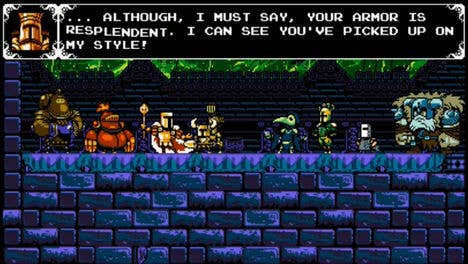
Shovel Knight, of course, is full of such moments, both comedic and heartbreaking. I could write a whole piece on the Order of No Quarter alone, and how they are so wonderfully characterized by their animation, their text boxes, and their individual sound effects, culminating in a boss rush battle royale over a great banquet ("It's sort of crazy —this was actually one of the very first ideas in the entire game. Once we knew we wanted 8 themed knights, the famous knights of the round table popped into our heads. The image of them being all rowdy was immediately summoned and too hard to resist," D'Angelo tells me). And then there are the people populating the world of Shovel Knight: Humans and animals, wizards and commoners, all jumbled together in a funhouse mirror reflection of a village in Zelda II.
Through it all, Shovel Knight demonstrates a real flair for visual storytelling, which along with some canny design choices serves to elevate it from retro tribute to something more. "In our eyes, the story would be that much more meaningful if people played it. If they felt the despair as Shovel Knight reached for Shield Knight, if they took part in the teamwork of Shield Knight and Shovel Knight in their heroic hour...giving the player the opportunity to play the story meant they would be more willing to put themselves in the game," D'Angelo says. "The key to a moving story is making room for empathy. Letting the player direct and participate in the tale gives them the chance to put their own emotions and stories into the gameplay."
Months after finishing the main story, it's that sort of emotional gameplay (along with a great soundtrack) that has kept Shovel Knight rattling around my mind. For that reason, I consider Shovel Knight one of the best games of the year—a beautiful little platform that transcends its roots and manages to stand shoulder-to-shoulder with this year's AAA productions. I can't see what adventures Shovel Knight and Shield Knight have next.


